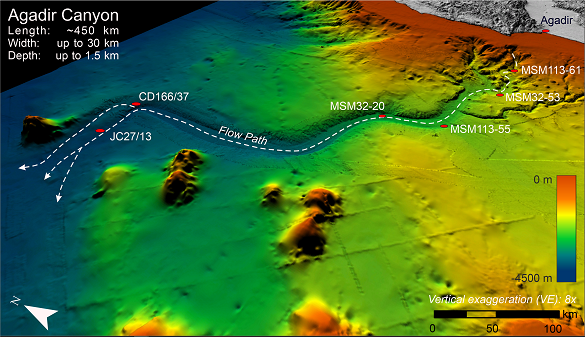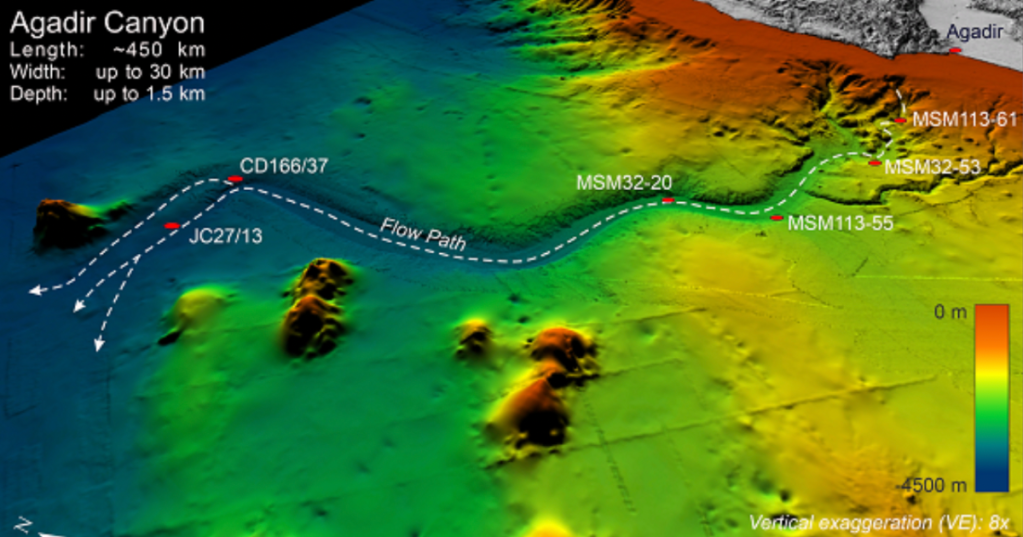
We’ve all seen the sometimes devastating impact of landslides and avalanches – whether on the news, online, or through our own eyes.
One thing that nobody has seen, however, is an avalanche that is happening under the sea.
However, researchers from the University of Liverpool, UK, have recently revealed the devastating impact of an underwater avalanche that happened over 60,000 years ago in the Agadir Canyon. This massive canyon, which is 450 km long, 30 km wide, and 1,250 meters deep is located off the south coast of Morocco, in the Atlantic ocean.
The research team, co-led by Dr Chris Stevenson, a sedimentologist from the University of Liverpool’s School of Environmental Sciences, were able to map the avalanche in a project that is, quite literally, ground-breaking.
However, this project was no easy feat; nor was it quick to complete.
The study involved the analysis of over 300 samples that had been collected over 40 years from various research cruises over the Agadir basin. They combined evidence from the samples with seismic data in order to create the map and explore the devastating underwater impact of the avalanche.
In a statement from the University of Liverpool, Dr Stevenson explained the magnitude of their findings:
“This is the first time anyone has managed to map out an entire individual underwater avalanche of this size and calculate its growth factor.
What is so interesting is how the event grew from a relatively small start into a huge and devastating submarine avalanche reaching heights of 200 meters as it moved at a speed of about 15 m/s, ripping out the sea floor and tearing everything out in its way.
To put it in perspective: that’s an avalanche the size of a skyscraper, moving at more than 40 mph from Liverpool to London, which digs out a trench 30 m deep and 15 km wide, destroying everything in its path. Then it spreads across an area larger than the UK burying it under about a metre of sand and mud.”
What is shocking about the team’s findings is not only the power of the avalanche – which eroded a total of around 4500 km2 of the canyon across its entire length – but also how it grew.
It is this growth – which is calculated by scientists as a growth factor – that made the avalanche quite so remarkable.
What started as a relatively small landslide on the sea floor grew to over 100 times its original size. When it comes to avalanches, this is a rare growth factor, and perhaps the key factor that made the landslide so devastating.
However, as the project’s co-lead Dr Christoph Bottner – a Marie-Curie research fellow at Aarhus University in Denmark – explains in the statement, this huge growth could be because the avalanche occurred underwater:
“We calculate the growth factor to be at least 100, which is much larger compared to snow avalanches or debris flows which only grow by about 4-8 times. We have also seen this extreme growth in smaller submarine avalanches measured elsewhere, so we think this might be a specific behaviour associated with underwater avalanches and is something we plan to investigate further.”
But what is the relevance of an underwater avalanche that happened over 60,000 years ago?
Well, a greater understanding of what happens on the sea floor could actually be fundamental to the continued functioning of our modern societies.
The study, which is published in the academic journal Science, could be the evidence we need to protect our hi-tech infrastructure.
As Professor Sebastian Krastel – head of Marine Geophysics at Kiel University and chief scientist aboard the cruises that mapped the canyon – explains, unpredicted seismic activity in the depths of the ocean could actually be detrimental to our daily lives:
“Our new insight fundamentally challenges how we view these events. Before this study, we thought that big avalanches only came from big slope failures. But now, we know that they can start small and grow into extremely powerful and extensive giant events.
These findings are of enormous importance for how we try and assess their potential geohazard risk to seafloor infrastructure like internet cables that carry almost all global internet traffic, which are critical to all aspects of our modern societies.”
So if you want to continue playing Fortnite and watching Netflix any time of the day or night – or, you know, for the global economy and all of the administrative systems required for the function of our societies to not collapse around you – this underwater map is pretty important in helping our vital infrastructure to be protected.
Let’s just hope there’s not another underwater avalanche of this magnitude tomorrow.
If you think that’s impressive, check out this story about a “goldmine” of lithium that was found in the U.S. that could completely change the EV battery game.
